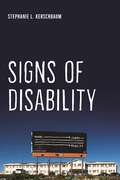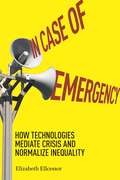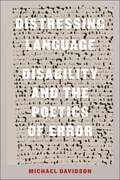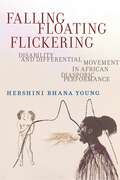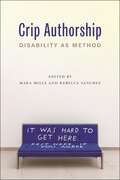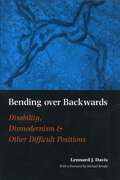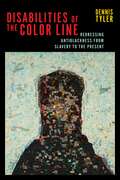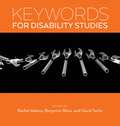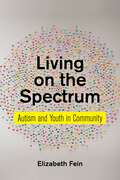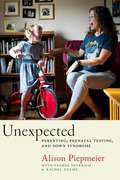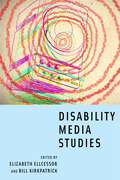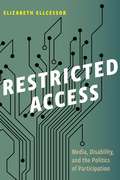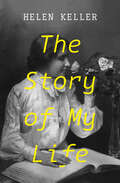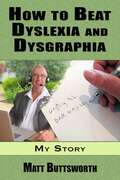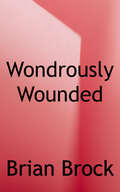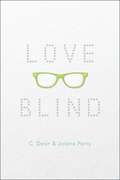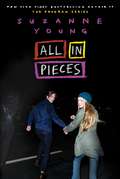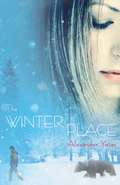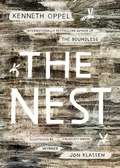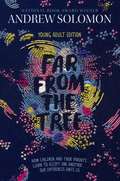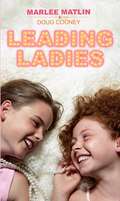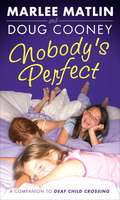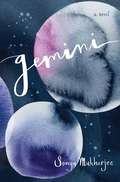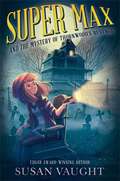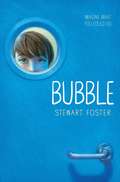- Table View
- List View
Signs of Disability (Crip #4)
by Stephanie L. KerschbaumHow can we learn to notice the signs of disability?We see indications of disability everywhere: yellow diamond-shaped “deaf person in area” road signs, the telltale shapes of hearing aids, or white-tipped canes sweeping across footpaths. But even though the signs are ubiquitous, Stephanie L. Kerschbaum argues that disability may still not be perceived due to a process she terms “dis-attention.”To tell better stories of disability, this multidisciplinary work turns to rhetoric, communications, sociology, and phenomenology to understand the processes by which the material world becomes sensory input that then passes through perceptual apparatuses to materialize phenomena—including disability. By adding perception to the understanding of disability’s materialization, Kerschbaum significantly expands our understanding of disability, accounting for its fluctuations and transformations in the semiotics of everyday life.Drawing on a set of thirty-three research interviews focused on disabled faculty members’ experiences with disability disclosure, as well as written narratives by disabled people, this book argues for the materiality of narrative, suggesting narratives as a means by which people enact boundaries around phenomena and determine their properties. Signs of Disability offers strategies and practices for challenging problematic and pervasive forms of “dis-attention” and proposes a new theoretical model for understanding disability in social, rhetorical, and material settings.
In Case of Emergency: How Technologies Mediate Crisis and Normalize Inequality
by Elizabeth EllcessorA much-needed look at the growth of emergency media and its impact on our livesIn an emergency, we often look to media: to contact authorities, to get help, to monitor evolving situations, or to reach out to our loved ones. Sometimes we aren’t even aware of an emergency until we are notified by one of the countless alerts, alarms, notifications, sirens, text messages, or phone calls that permeate everyday life. Yet most people have only a partial understanding of how such systems make sense of and act upon an “emergency.” In Case of Emergency argues that emergency media are profoundly cultural artifacts that shape the very definition of “emergency” as an opposite of “normal.” Looking broadly across a range of contemporary emergency-related devices, practices, and services, Elizabeth Ellcessor illuminates the cultural and political underpinnings and socially differential effects of emergency media. By interweaving in-depth interviews with emergency-operation and app-development experts, archival materials, and discursive and technological readings of hardware and infrastructures, Ellcessor demonstrates that emergency media are powerful components of American life that are rarely, if ever, neutral. The normalization of ideologies produced and reinforced by emergency media result in unequal access to emergency services and discriminatory assumptions about who or what is a threat and who deserves care and protection. As emergency media undergo massive growth and transformation in response to digitization and attendant entrepreneurial cultures, Ellcessor asks where access, equity, and accountability fit in all of this. The first book to develop a typology of emergency media, In Case of Emergency opens a much-needed conversation around the larger cultural meanings of “emergency,” and what an ethical and care-based approach to emergency could entail.
Distressing Language: Disability and the Poetics of Error (Crip)
by Michael DavidsonThe role of disability and deafness in artDistressing Language is full of mistakes—errors of hearing, speaking, writing, and understanding. Michael Davidson engages the role of disability and deafness in contemporary aesthetics, exploring how physical and intellectual differences challenge our understanding of art and poetry. Where hearing and speaking are considered normative conditions of the human, what happens when words are misheard and misspoken? How have writers and artists, both disabled and non-disabled, used error as generative elements in contesting the presumed value of “sounding good”? Distressing Language grows out of the author’s experience of hearing loss in which misunderstandings have become a daily occurrence. Davidson maintains that verbal confusions are less an aberration in understanding than a component of new knowledge.Davidson discusses a range of sites, from captioning errors and Bad Lip Reads on YouTube, to the deaf artist Christine Sun Kim’s audiovisual installations, and a poetic reinterpretation of the Biblical Shibboleth responding to the atrocities of the Holocaust. Deafness becomes a guide in each chapter of Distressing Language, giving us a closer look at a range of artistic mediums and how artists are working with the axiom of “error” to produce novel subjecthoods and possibilities.
Falling, Floating, Flickering: Disability and Differential Movement in African Diasporic Performance (Crip #7)
by Hershini Bhana YoungInsists on the importance of embodiment and movement to the creation of Black socialityLinking African diasporic performance, disability studies, and movement studies, Falling, Floating, Flickering approaches disability transnationally by centering Black, African, and diasporic experiences. By eschewing capital’s weighted calculus of which bodies hold value, this book centers alternate morphologies and movement practices that have previously been dismissed as abnormal or unrecognizable. To move beyond binaries of ability, Hershini Bhana Young traverses multiple geohistories and cultural forms stretching from the United States and the Mediterranean to Sierra Leone, Nigeria, and South Africa, as well as independent and experimental film, novels, sculptures, images, dance, performances, and anecdotes. In doing so, she argues for the importance of differential embodiment and movement to the creation and survival of Black sociality, and refutes stereotypic notions of Africa as less progressive than the West in recognizing the rights of disabled people. Ultimately, this book foregrounds the engagement of diasporic Africans, who are still reeling from the violence of colonialism, slavery, poverty, and war, as they gesture toward a liberatory Black sociality by falling, floating, and flickering.
Crip Authorship: Disability as Method
by Mara Mills and Rebecca SanchezAn expansive volume presenting crip approaches to writing, research, and publishingCrip Authorship: Disability as Method is an expansive volume presenting the multidisciplinary methods brought into being by disability studies and activism. Mara Mills and Rebecca Sanchez have convened leading scholars, artists, and activists to explore the ways disability shapes authorship, transforming cultural production, aesthetics, and media.Starting from the premise that disability is plural and authorship spans composition, affect, and publishing, this collection of thirty-five compact essays asks how knowledge about disability is produced and shared in disability studies. Disability alters, generates, and dismantles method. Crip authorship takes place within and beyond the commodity version of authorship, in books, on social media, and in creative works that will never be published. The chapters draw on the expertise of international researchers and activists in the humanities, social sciences, education, arts, and design. Across five sections—Writing, Research, Genre/Form, Publishing, Media—contributors consider disability as method for creative work: practices of writing and other forms of composition; research methods and collaboration; crip aesthetics; media formats and hacks; and the capital, access, legal standing, and care networks required to publish. Designed to be accessible and engaging for students, Crip Authorship also provides theoretically sophisticated arguments in a condensed form that will make the text a key resource for disability studies scholars. Essays include Mel Y Chen on the temporality of writing with chronic illness; Remi Yergeau on perseveration; La Marr Jurelle Bruce on mad Black writing; Alison Kafer on the reliance of the manifesto genre on disability; Jaipreet Virdi on public scholarship for disability justice; Ellen Samuels on the importance of disability and illness to autotheory; Xuan Thuy Nguyen on decolonial research methods for disability studies; Emily Lim Rogers on virtual ethnography; Cameron Awkward-Rich on depression and trans reading methods; Robert McRuer on crip theory in translation; Kelsie Acton on plain language writing; and Georgina Kleege on description as an access and aesthetic technique.
Bending Over Backwards: Essays on Disability and the Body (Cultural Front #6)
by Lennard J. DavisWith the advent of the human genome, cloning, stem-cell research and many other developments in the way we think of the body, disability studies provides an entirely new way of thinking about the body in its relation to politics, the environment, the legal system, and global economies. Bending Over Backwards reexamines issues concerning the relationship between disability and normality in the light of postmodern theory and political activism. Davis takes up homosexuality, the Americans with Disabilities Act, the legal system, the history of science and medicine, eugenics, and genetics. Throughout, he maintains that disability is the prime category of postmodernity because it redefines the body in relation to concepts of normalcy, which underlie the very foundations of democracy and humanistic ideas about the body. Bending Over Backwards argues that disability can become the new prism through which postmodernity examines and defines itself, supplanting the categories of race, class, gender, and sexual orientation.
Disabilities of the Color Line: Redressing Antiblackness from Slavery to the Present (Crip #5)
by Dennis TylerReveals how disability and disablement have shaped Black social life in AmericaThrough both law and custom, the color line has cast Black people as innately disabled and thus unfit for freedom, incapable of self-governance, and contagious within the national body politic. Disabilities of the Color Line maintains that the Black literary tradition historically has inverted this casting by exposing the disablement of racism without disclaiming disability.In place of a triumphalist narrative of overcoming where both disability and disablement alike are shunned, Dennis Tyler argues that Black authors and activists have consistently avowed what he calls the disabilities of the color line: the historical and ongoing anti-Black systems of division that maim, immobilize, and stigmatize Black people. In doing so, Tyler reveals how Black writers and activists such as David Walker, Henry Box Brown, William and Ellen Craft, Charles Chesnutt, James Weldon Johnson, and Mamie Till-Mobley have engaged in a politics and aesthetics of redress: modes of resistance that, in the pursuit of racial and disability justice, acknowledged the disabling violence perpetrated by anti-Black regimes in order to conceive or engender dynamic new worlds that account for people of all abilities. While some writers have affirmed disability to capture how their bodies, minds, and health have been made vulnerable to harm and impairment by the state and its citizens, others’ assertion of disability symbolizes a sense of community as well as a willingness to imagine and create a world distinct from the dominant social order.
Keywords for Disability Studies (Keywords #7)
by Rachel Adams David Serlin Benjamin ReissKeywords for Disability Studies aims to broaden and define the conceptual framework of disability studies for readers and practitioners in the field and beyond. The volume engages some of the most pressing debates of our time, such as prenatal testing, euthanasia, accessibility in public transportation and the workplace, post-traumatic stress, and questions about the beginning and end of life. Each of the 60 essays in Keywords for Disability Studies focuses on a distinct critical concept, including "ethics," "medicalization," "performance," "reproduction," "identity," and "stigma," among others. Although the essays recognize that "disability" is often used as an umbrella term, the contributors to the volume avoid treating individual disabilities as keywords, and instead interrogate concepts that encompass different components of the social and bodily experience of disability. The essays approach disability as an embodied condition, a mutable historical phenomenon, and a social, political, and cultural identity. An invaluable resource for students and scholars alike, Keywords for Disability Studies brings the debates that have often remained internal to disability studies into a wider field of critical discourse, providing opportunities for fresh theoretical considerations of the field's core presuppositions through a variety of disciplinary perspectives. Visit keywords.nyupress.org for online essays, teaching resources, and more.
Living on the Spectrum: Autism and Youth in Community (Anthropologies of American Medicine: Culture, Power, and Practice #8)
by Elizabeth FeinHow youth on the autism spectrum negotiate the contested meanings of neurodiversityAutism is a deeply contested condition. To some, it is a devastating invader, harming children and isolating them. To others, it is an asset and a distinctive aspect of an individual’s identity. How do young people on the spectrum make sense of this conflict, in the context of their own developing identity? While most of the research on Asperger’s and related autism conditions has been conducted with individuals or in settings in which people on the spectrum are in the minority, this book draws on two years of ethnographic work in communities that bring people with Asperger’s and related conditions together. It can thus begin to explore a form of autistic culture, through attending to how those on the spectrum make sense of their conditions through shared social practices.Elizabeth Fein brings her many years of experience in both clinical psychology and psychological anthropology to analyze the connection between neuropsychological difference and culture. She argues that current medical models, which espouse a limited definition, are ill equipped to deal with the challenges of discussing autism-related conditions. Consequently, youths on the autism spectrum reach beyond medicine for their stories of difference and disorder, drawing instead on shared mythologies from popular culture and speculative fiction to conceptualize their experience of changing personhood. In moving and persuasive prose, Living on the Spectrum illustrates that young people use these stories to pioneer more inclusive understandings of what makes us who we are.
Unexpected: Parenting, Prenatal Testing, and Down Syndrome
by Alison PiepmeierWhat prenatal tests and down syndrome reveal about our reproductive choicesWhen Alison Piepmeier—scholar of feminism and disability studies, and mother of Maybelle, an eight-year-old girl with Down syndrome—died of cancer in August 2016, she left behind an important unfinished manuscript about motherhood, prenatal testing, and disability. In Unexpected, George Estreich and Rachel Adams pick up where she left off, honoring the important research of their friend and colleague, as well as adding new perspectives to her work.Based on interviews with parents of children with Down syndrome, as well as women who terminated their pregnancies because their fetus was identified as having the condition, Unexpected paints an intimate, nuanced picture of reproductive choice in today’s world. Piepmeier takes us inside her own daughter’s life, showing how Down syndrome is misunderstood, stigmatized, and condemned, particularly in the context of prenatal testing.At a time when medical technology is rapidly advancing, Unexpected provides a much-needed perspective on our complex, and frequently troubling, understanding of Down syndrome.
Disability Media Studies
by Elizabeth Ellcessor and Bill KirkpatrickIntroduces key ideas and offers a sense of the new frontiers and questions in the emerging field of disability media studies Disability Media Studies articulates the formation of a new field of study, based in the rich traditions of media, cultural, and disability studies. Necessarily interdisciplinary and diverse, this collection weaves together work from scholars from a variety of disciplinary homes, into a broader conversation about exploring media artifacts in relation to disability. The book provides a comprehensive overview for anyone interested in the study of disability and media today. Case studies include familiar contemporary examples—such as Iron Man 3, Lady Gaga, and Oscar Pistorius—as well as historical media, independent disability media, reality television, and media technologies. The contributors consider disability representation, the role of media in forming cultural assumptions about ability, the construction of disability via media technologies, and how disabled audiences respond to particular media artifacts. The volume concludes with afterwords from two different perspectives on the field—one by disability scholar Rachel Adams, the other by media scholars Mara Mills and Jonathan Sterne—that reflect upon the collection, the ongoing conversations, and the future of disability media studies. Disability Media Studies is a crucial text for those interested in this flourishing field, and will pave the way for a greater understanding of disability media studies and its critical concepts and conversations.
Restricted Access: Media, Disability, and the Politics of Participation (Postmillennial Pop #6)
by Elizabeth EllcessorWhile digital media can offer many opportunities for civic and cultural participation, this technology is not equally easy for everyone to use. Hardware, software, and cultural expectations combine to make some technologies an easier fit for some bodies than for others. A YouTube video without closed captions or a social network site that is incompatible with a screen reader can restrict the access of users who are hard of hearing or visually impaired. Often, people with disabilities require accommodation, assistive technologies, or other forms of aid to make digital media accessible--useable--for them. Restricted Access investigates digital media accessibility--the processes by which media is made usable by people with particular needs--and argues for the necessity of conceptualizing access in a way that will enable greater participation in all forms of mediated culture. Drawing on disability and cultural studies, Elizabeth Ellcessor uses an interrogatory framework based around issues of regulation, use, content, form, and experience to examine contemporary digital media. Through interviews with policy makers and accessibility professionals, popular culture and archival materials, and an ethnographic study of internet use by people with disabilities, Ellcessor reveals the assumptions that undergird contemporary technologies and participatory cultures. Restricted Access makes the crucial point that if digital media open up opportunities for individuals to create and participate, but that technology only facilitates the participation of those who are already privileged, then its progressive potential remains unrealized. Engagingly written with powerful examples, Ellcessor demonstrates the importance of alternate uses, marginalized voices, and invisible innovations in the context of disability identities to push us to rethink digital media accessibility.
The Story of My Life: With Her Letters (1887-1901) And A Supplementary Account Of Her Education, Including Passages From The Reports And Letters Of Her Teacher, Anne Mansfield Sullivan, By John Albert Macy
by Helen KellerA classic of American autobiography—the remarkable story of Helen Keller&’s early life and education At nineteen months old, Helen Keller was stricken with a mysterious illness that left her deaf and blind. For the next five years, she was trapped in the silent dark, her only means of communication a few dozen rudimentary signs. Her inability to express herself was a great source of frustration, and as she grew older, Helen became prone to angry outbursts and fits of despair. Her family sought help, and in March of 1887, twenty-year-old Anne Sullivan arrived from the Perkins Institution for the Blind. One month later, teacher and student made the first of many incredible breakthroughs. By placing one of Helen&’s hands under cool running water and tracing the letters w-a-t-e-r on her other hand, Anne was able to convey the great mystery of language: that every object has a name. As Helen would later write in The Story of My Life, &“That living word awakened my soul.&” Covering the first twenty-two years of Helen Keller&’s life, from that miraculous moment at the water pump to her acceptance into Radcliffe College, The Story of My Life is one of the most beloved and inspiring autobiographies ever written. The basis for The Miracle Worker, the Tony Award–winning play and Academy Award–winning film, its heartening message has touched millions of lives and torn down countless barriers the world over. This ebook has been professionally proofread to ensure accuracy and readability on all devices.
How to Beat Dyslexia and Dysgraphia: My Story
by Matt ButtsworthMy name is Matt Buttsworth. I have suffered from dyslexia and dysgraphia all my life and I know how difficult it can be to learn to read or to learn how to write legibly or to type without a thousand uncontrollable errors. I also know as a teacher and from my own at times bitter personal experience how difficult it can be to get effective help, and what terrible obstacles and terrible blows people suffering from dyslexia and dysgraphia can face . <p><p>But despite these disabilities, I have triumphed. I taught myself to read, to type using code systems and to use the latest voice dictation technology to help me create almost error free texts. Something I could never do at an earlier age when all I could do was write or type. And through hard work, perseverance and with the use of these techniques and computer programs I have been able to become a published author with a number of academic texts and novels available for sale on Amazon and to gain a PhD. <p><p>This book is about providing you with the practical skills and the latest available information on which word processing programs and which voice dictation programs someone suffering from dyslexia or dysgraphia should use and how to most effectively use them. I hope you find it of use in helping you too beat dyslexia and dysgraphia.
Wondrously Wounded: Theology, Disability, and the Body of Christ
by Brian BrockThe church welcomes all―or it should. <p><p> The church has long proven itself a safe refuge despite the sad reality that it can be, and has been, unwelcoming toward those perceived as different. This is especially true of the contemporary church’s response to those with disabilities―a response often at surprising variance with its historic practices of care. The church once helped shape western morality to cherish these individuals with love and acceptance. It is thus ironic when today’s church neglects this care, or practices care with no awareness of the rich theological history out of which such moral sensibilities originally emerged. In Wondrously Wounded, Brian Brock reclaims the church’s historic theology of disability and extends it to demonstrate that people with disabilities, like all created in God’s image, are servants of God’s redemptive work. <p><p> Brock divides his volume into five parts. Part one chronicles how early Christianity valued and cared for those with disabilities, putting into practice Jesus’ teachings about divine mercy in decidedly countercultural ways. Part two details how a rise in the fear of disability tempted the church away from these merciful practices as well as its confession of the infinite worth of all God has created. Part three traces how the fear of difference continues to negatively shape contemporary practices in today’s schools, churches, and politics. Part four lays the foundations of a vision of Christian life that is resistant to this pervasive fear. Finally, Part five shows how the recognition of all people as part of the body of Christ not only demonstrates the love of Christ but displaces the fear of disability in a manner that invites the church beyond even the most ambitious contemporary hopes for full inclusion. <p><p> Brock interweaves his historical and theological analysis with the narrative of his own disabled son, Adam. These stories vividly bring into view the vulnerability, as well as the power, of the disabled in contemporary society. Ultimately, Brock argues, those with disabilities are conduits of spiritual gifts that the church desperately needs. Wondrously Wounded is an appeal to the church to find itself broken and remade by the presence of Christ on offer in the lives of those society has labeled "disabled."
Love Blind
by C. Desir Jolene Perry<P>Shy high schooler Kyle Jamieson and Hailey Bosler, a musician with degenerative blindness, team up to tackle a bucket list of greatest fears in this compelling novel that explores what it means to take risks. <P>It starts with a list of fears. Stupid things really. Things that Hailey shouldn't worry about, wouldn't worry about if she didn't wake up every morning with the world a little more blurry. Unable to see her two moms clearly. Unable to read the music for her guitar. One step closer to losing the things she cares about the most. For a while, the only thing that keeps Hailey moving forward is the feeling she gets when she crosses something off the list. Then she meets Kyle. He mumbles--when he talks at all--and listens to music to drown out his thoughts. He's loaded down with fears, too. So Hailey talks him into making his own list. Together, they stumble into an odd friendship, helping each other tackle one after another of their biggest fears. But fate and timing can change everything. And sometimes facing your worst fear makes you realize you had nothing to lose after all.
All in Pieces
by Suzanne YoungFrom <i>New York Times</i> bestselling author Suzanne Young comes a heartrending new novel about a girl struggling to deal with anger issues while taking care of her younger brother with special needs. <p>"Anger-management issues." That's how they classified Savannah Sutton after she stuck a pencil in her ex-boyfriend's hand because he mocked her little brother, Evan, for being disabled. That's why they sent her to Brooks Academy--an alternative high school that's used as a temporary detention center. <p>The days at Brooks are miserable, but at home, life is far more bleak. Savvy's struggling to take care of her brother since her mom left years ago, and her alcoholic dad can't be bothered. Life with Evan is a constant challenge, but he's also the most important person in the world to Savvy. <p>Then there's Cameron, a new student at Brooks with issues of his own; a guy from a perfect family that Savvy thought only existed on TV. Cameron seems determined to break through every one of the walls Savvy's built around herself, except if she lets herself trust him, it could make everything she's worked so hard for fall apart in an instant. <p>And with her aunt seeking custody of her brother and her ex-boyfriend seeking revenge, Savvy's fighting to hold all the pieces together. But she's not sure how much tighter she can be pulled before she breaks completely.</p>
The Winter Place
by Alexander YatesThere is a middle world between life and death, and Tess must navigate it to save her brother in this heart-wrenching story infused with the fractured and fantastical realms of Finnish mysticism.Axel and Tess are bewildered when a stranger shows up in their backyard accompanied by a giant brown bear, but before they can investigate the bizarre encounter, something more harrowing happens: their father is killed in a freak car accident. Now orphaned, Tess and Axel are shipped off to Finland to live with grandparents who they've never met, and are stunned to discover that the mysterious stranger with the bear has found them again. More stunning--they come to understand that this man isn't really a man...he's a keeper of souls. And the bear isn't really a bear...it's a ghost. Their mother's ghost. Wandering, endlessly, searching for their father. Then the Keeper invites Axel, who is fighting his symptoms of muscular dystrophy, to join the path of the dead--and when Axel disappears into the deep snow, Tess knows she must find a way to follow. There are mysteries connected to this peculiar man, this keeper, and if she can untangle them, she might not only save Axel, but also bring her parents peace.
The Nest
by Kenneth Oppel Jon Klassen<P>Steve just wants to save his baby brother--but what will he lose in the bargain? This is a haunting gothic tale for fans of Coraline, from acclaimed author Kenneth Oppel (Silverwing, The Boundless) with illustrations from Caldecott Medalist Jon Klassen. <P>For some kids summer is a sun-soaked season of fun. But for Steve, it's just another season of worries. Worries about his sick newborn baby brother who is fighting to survive, worries about his parents who are struggling to cope, even worries about the wasp's nest looming ominously from the eaves. So when a mysterious wasp queen invades his dreams, offering to "fix" the baby, Steve thinks his prayers have been answered. All he has to do is say "Yes." But "yes" is a powerful word. It is also a dangerous one. And once it is uttered, can it be taken back? Celebrated author Kenneth Oppel creates an eerie masterpiece in this compelling story that explores disability and diversity, fears and dreams, and what ultimately makes a family. <P><b> Nominee for the 2018 Young Reader's Choice Award </b> <i>(Pacific Northwest Library Association)</i>
Far from the Tree: Young Adult Edition--How Children and Their Parents Learn to Accept One Another . . . Our Differences Unite Us
by Andrew Solomon Laurie CalkhovenFrom New York Times bestselling author Andrew Solomon comes a stunning, poignant, and affecting young adult edition of his award-winning masterpiece, Far From the Tree, which explores the impact of extreme differences between parents and children.The old adage says that the apple doesn’t fall far from the tree, meaning that children usually resemble their parents. But what happens when the apples fall somewhere else—sometimes a couple of orchards away, sometimes on the other side of the world? In this young adult edition, Andrew Solomon profiles how families accommodate children who have a variety of differences: families of people who are deaf, who are dwarfs, who have Down syndrome, who have autism, who have schizophrenia, who have multiple severe disabilities, who are prodigies, who commit crimes, and more. Elegantly reported by a spectacularly original and compassionate thinker, Far From the Tree explores how people who love each other must struggle to accept each other—a theme in every family’s life. The New York Times calls the adult edition a “wise and beautiful” volume, that “will shake up your preconceptions and leave you in a better place.”
Leading Ladies
by Marlee Matlin Doug Cooney"It doesn't make sense to me...in the book, Dorothy is a girl who can hear and talk - and Toto is a little dog. So I'm sorry - but I just don't see a Dorothy who's deaf and talks with her hands and has a great big dog for Toto!" Megan's fourth-grade class is putting on their own original musical based on the book The Wizard of Oz, and Megan wants to be the star of the show and play Dorothy. Since she's deaf, she will sign the songs for her audition. However, a problem develops when Lizzie, her best friend from camp, transfers from her all-deaf school to Megan's class - and signs the same two songs that Megan was going to do! Luckily, Megan has some other ideas up her sleeve... Academy Award-winning actress Marlee Matlin and Doug Cooney follow Deaf Child Crossing and Nobody's Perfect with this winning story that perfectly captures the humor, joys, and frustration of childhood friendships.
Nobody's Perfect
by Marlee Matlin Doug CooneyMegan has spent forever planning her positively purple birthday sleepover. She's even made glittery purple invitations for every girl in her class. Then a new girl, Alexis Powell, joins their class. Alexis seems perfect: She's smart, pretty, and rules the soccer games on the playground. But no matter how hard Megan tries to be a friend to Alexis, the new girl is aloof or rude. At first Megan thinks Alexis is shy. Then Megan starts to fear that Alexis is treating her differently because she's deaf. When the girls are forced to collaborate on a science fair project, Megan learns the truth -- and realizes that nobody's perfect. Once again Marlee Matlin draws on experiences from her own childhood to tell Megan's story. In this funny, poignant book, readers will root for Megan, a spirited young girl who doesn't let anything stand in her way.
Gemini
by Sonya MukherjeeIn a powerful and daring debut novel, Sonya Mukherjee shares the story of sisters Clara and Hailey, conjoined twins who are learning what it means to be truly extraordinary.Seventeen-year-old conjoined twins, Clara and Hailey, have lived in the same small town their entire lives--no one stares at them anymore. But there are cracks in their quiet existence and they're slowing becoming more apparent. Clara and Hailey are at a crossroads. Clara wants to stay close to home, avoid all attention, and study the night sky. Hailey wants to travel the world, learn from great artists, and dance with mysterious boys. As high school graduation approaches, each twin must untangle her dreams from her sister's, and figure out what it means to be her own person. Told in alternating perspectives, this unconventional coming-of-age tale shows how dreams can break your heart--but the love between sisters can mend it.
Super Max and the Mystery of Thornwood's Revenge
by Susan VaughtIt’s going to take more than a knack for electronics and a supercharged wheelchair for twelve-year-old Max to investigate a haunted mansion in Edgar Award–winning author Susan Vaught’s latest middle grade mystery.Max has always been a whiz with electronics (just take a look at her turbo-charged wheelchair). But when a hacker starts a slanderous Facebook page for her grandpa, Max isn’t sure she has the skills to take him down. The messages grow increasingly sinister, and Max fears that this is more than just a bad joke. Here’s the thing: Max has grown up in the shadow of Thornwood Manor, an abandoned mansion that is rumored to be haunted by its original owner, Hargrove Thornwood. It is said that his ghost may be biding his time until he can exact revenge on the town of Blue Creek. Why? Well, it’s complicated. To call him a jerk would be an understatement. When the hacking escalates, suddenly it looks to Max like this could really be Thornwood’s Revenge. If it is, these messages are just the beginning—and the town could be in danger.
Bubble
by Stewart FosterWonder meets Mark Haddon in the poignant and uplifting debut novel about superheroes, super-nurses, and the beauty you can find in hope.Eleven-year-old Joe has never had a life outside of the hospital, with its beeping machines and view of London’s rooftops. His condition means he’s not allowed outside, not even for a moment, and his few visitors risk bringing life-threatening germs inside his bubble. Then a new nurse offers Joe the possibility of going outside. But Joe doesn’t know if the nurse is serious—or whether he could survive the adventure. Bubble is the touching story of how Joe spends his days, copes with his loneliness and frustration, and looks—with superhero-style bravery, curiosity, and hope—to a future without limits.
